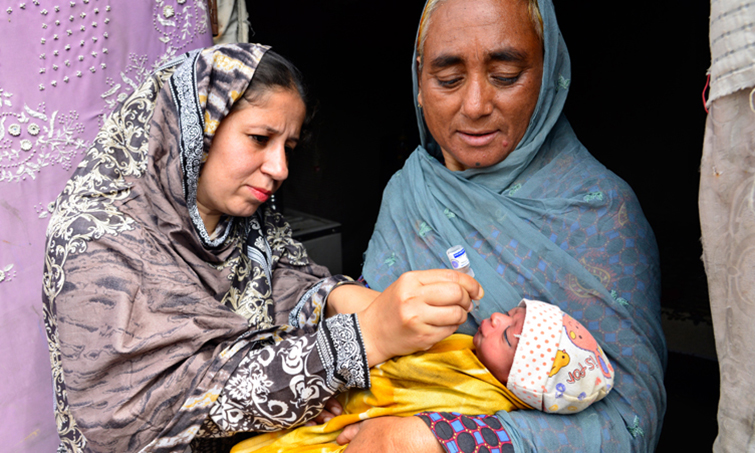Rawalpindi, 11 Sep. 2017: On a small muddy patch encircled by nomadic tents in Rawalpindi, 50 years old Sakina tries to sooth her four-day old grandson, Zain, who is about to receive his first ever dose of the oral polio vaccine.
Sakina has come all the way from Multan in South Punjab along with her daughter, son-in-law and Zain as a guests to the equally mobile family of Amna Bibi residing in Union Council Cant.10. Like many who travel between the cities for this reason, she has also come here to attend a wedding.

In Rawalpindi, especially, a significant proportion of the population is transient; it’s like a junction where people move from one province to another for reasons ranging from work or to attending family gatherings or religious festivals. Children on the move with their parents are particularly at risk of missing out on their polio vaccination.
Pakistan has come a long way toward polio eradication. The progress achieved since the beginning of 2015 is now clearly visible in the declining number of wild poliovirus cases from 306 in 2014 to 54 in 2015, and 20 in 2016. So far in 2017 the total number of cases reported stands at five, compared to 16 this time last year. But clearly the final battle against polio is yet to be won. While the overall risk across the general population has decreased, the relative risk posed by high-risk and mobile population groups continues to increase, albeit incrementally.
UC Cant.10 where Zain has landed, is among the 192 union councils that are considered high-risk for the poliovirus. A team of Sehat Muhafiz vaccinators with blue boxes sling over their shoulders set on leaving no child in the settlement unvaccinated. While Zain receives two drops of the vaccine, the host, Amna Bibi chips in “my seven grandchildren get vaccinated each time the vaccinators come at our doorstep; we do not have to go anywhere.”
“Mobile and migrant populations are under-vaccinated compared to settled groups. As a result, they act as a vehicle carrying the virus to and from the reservoir and diluting population immunity.” says the District Health Officer of Rawalpindi, Dr Abdul Jabbar while putting the finishing touches of the vaccination campaign that is about to start by the end of October.
We have been running successful vaccination campaigns to boost children’s immunity to the virus. However, in 2016 we realized that the virus continues to lurk in the environment, bringing alarming results.” adds Dr Abdul Jabbar.
“Improved understanding of the movement patterns and timings to and from the core reservoirs for high-risk mobile children both within Pakistan and along each of the three cross-border transmission corridors was hence essential to strengthening our outreach and vaccination of these children by community-based vaccinators and transit teams.”, says Bushra Ajmal the District Health Communication Support Officer who has all but done with the high-risk and mobile population mapping in Rawalpindi.
To reach the large and highly mobile population of children moving with their families across Pakistan, into Afghanistan, and back again requires accessing detailed local knowledge, in-depth social data as well as the much needed support from communities”, maintains Bushra.
Determined to reach every last child, the polio programme has gone to them; vaccinating children at train stations, bus stands and busy intersections. Transit vaccinators visit sites where their parents are working; like brick kilns, construction sites and agricultural field huts.
“How to reach children where they leave from and where they land, even if that “landing” is only for a few days stay at a relative’s house, is by no means easy. It requires a different approach to the process of microplanning and immunization activities.” says Sidrah Nouman, Union Council Communication Support Officer who has just administered the drops to Zain.
“The gold standard is that every child should be on someone’s micro plan. To reach travelling communities, it’s critical to enlist community leaders and prominent individuals in the immunization effort”, adds Sidrah.
In order to avoid the dangers posed by the movement of population between the polio virus reservoirs and other regions, transit vaccination points were placed at the international border, interprovincial border, and the core reservoirs. This approach, whilst necessary and important, is not sufficient to ensure vaccination of hundreds of thousands of children for the number of times required to sustain adequate immunity levels.
“Vaccination of children on the move is a cornerstone of the polio eradication strategy in Punjab. In order to ensure accurate tracking and vaccination of the thousands of mobile children, we have introduced the Blue Card. The card bears the name, age and gender of the child along with the date he or she was vaccinated at the permanent transit point upon arrival or departure.” adds Dr Abdul Jabbar.
During increased movement of mobile populations during holidays and seasonal movements, additional temporary transit teams are deployed on the most important routes. Engaging roaming teams during vaccination drives helped immunizing children visiting private clinics, hospitals, shrines, outlets of traditional and spiritual healers and other public service centres.
Through the 2016-2017 low transmission season, around 15 million children were vaccinated at the permanent transit sites, including points at the Pakistan –Afghanistan border and almost five million vaccinated at temporary sites during campaign days.
